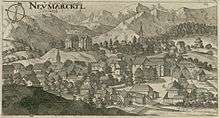Tržič
| Tržič Občina Tržič | |
|---|---|
| Town and Municipality | |
 | |
 Location of the Municipality of Tržič in Slovenia | |
 Tržič Location of the Town of Tržič in Slovenia | |
| Coordinates: 46°22′N 14°19′E / 46.367°N 14.317°ECoordinates: 46°22′N 14°19′E / 46.367°N 14.317°E | |
| Country |
|
| Government | |
| • Mayor | Borut Sajovic |
| Area | |
| • Total | 155.4 km2 (60.0 sq mi) |
| Population (2002)[1] | |
| • Total | 15,851 |
| • Density | 100/km2 (260/sq mi) |
| Time zone | CET (UTC+01) |
| • Summer (DST) | CEST (UTC+02) |
Tržič (pronounced [təɾˈʒitʃ]; German: Neumarktl) is a town and municipality in northern Slovenia, close to the Austrian border. As of 2007 the town had a population of 15,851.
Geography
The town is located within the historic Upper Carniola region on the Tržič Bistrica River, a left tributary of the Sava. In the north, the road leads up to the Loibl Pass in the Karawanks mountain range, the border with the Austrian state of Carinthia.
History

A first settlement named Forum in Lubelino was founded on the Roman road that ran from the ancient city of Emona (in present-day Ljubljana) via Loibl Pass to Virunum and the Zollfeld plain in the Noricum province (present-day Carinthia). After a massive landslide caused by an earthquake, the original settlement was destroyed and many people moved down the valley to establish a new village named Neumarktl where Tržič is now located (these events are the basis of the legend about the origin of Tržič).
The settlement in the Duchy of Carniola was granted market rights to hold weekly fairs by the Habsburg emperor Frederick III in 1492, which further promoted the development of the town. The great fire of 1811, which destroyed the buildings on the left bank of the Tržiška Bistrica River, changed the town. Much of the architecture was reconstructed in a Classicist style. After the buildings were rebuilt they needed to have firewalls, iron doors, and window covers, a very rare feature in Europe. The town center of Tržič has been protected as a cultural heritage site since 1985.
Economy
The leather, wood, and textile industries were important to the economy of Tržič in the past but industrial activity declined after the breakup of Yugoslavia. The development of small business after this period is now an important branch of the economy.
Because of its alpine setting, alpine skiing is popular in the surrounding area.
Notable people
Notable people that were born or lived in Tržič include:
- Feliks Anton Dev (a.k.a. Joannes Demascenus, 1732–1786), poet, translator, and editor[2]
- Countess Francisca von Strassoldo Grafenberg (1781–1854), wife of Austrian General Joseph Radetzky.
References
External links
- Municipal website (Slovenian)
- Tourism information (Slovenian)
- Unofficial website about Tržič (Slovenian)
| Wikimedia Commons has media related to Tržič. |